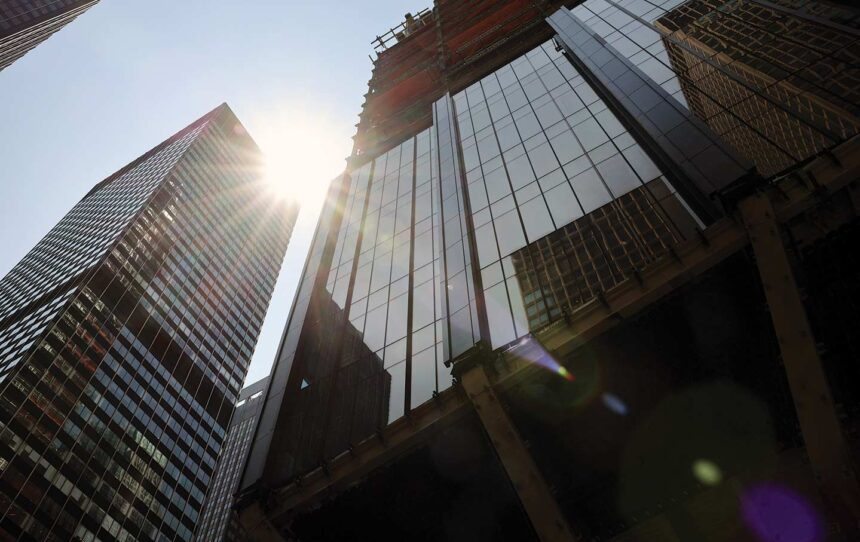Books & the Arts
/
June 16, 2025
Norman Foster’s 270 Park and the rise of the new office building.
The building’s dramatic and dazzling feats of architecture make it appear as if it were hovering above the street. But is that a good thing?

270 Park Avenue in New York City.
(Spencer Platt / Getty images)
One Sunday morning in Hong Kong, not long before the moment in 1997 when Great Britain handed its former colony back to China, I went for a run around the Peak, a towering hill that provides some much-needed green space in an unbelievably dense city. Afterward, I meandered down toward the Star Ferry dock in Victoria Harbour and was startled by an eerie, unidentifiable sound. It was loud and high-pitched, like an enormous flock of birds.
The sound kept getting louder as I approached the HSBC building, a landmark office tower, completed in 1986, that was famous among the architectural cognoscenti for appearing to be made from an entirely different kit of parts than most buildings of the period. The HSBC building was neither a smooth glass box nor an exercise in postmodernism, festooned with imitation classical ornamentation. Instead, it had an Erector Set aesthetic, with an exoskeleton that looked as though it had been painstakingly crafted by a 10-year-old boy. The building had been my introduction to its architect, Norman Foster, but I’d never quite grasped its appeal. What I encountered that day, however, would turn Foster into a longtime hero of mine.
The 44-story building was a remarkably open structure with offices lining both sides of a full-height central atrium. The tower roosted atop an open-air, ground-level plaza, protecting the space beneath it from Hong Kong’s hot sun and tropical downpours. As it turned out, Sunday was the one day off for the nannies and housekeepers of the city. Hundreds, perhaps thousands, of these people, freed for a day from childcare or housework, were gathered in the outdoor space beneath the building to partake in communal picnics. The sound I’d heard was that of a massive number of women talking to each other more or less at once. And the scene—something that no architect, even one as clever as Foster, could have anticipated or planned for—endeared the building to me forever.
For a decade or two after, I admired Foster’s output: his glass dome atop Berlin’s Reichstag, his Bilbao metro system (the glass-arched entryways to the stations are referred to locally as “Fosteritos”), his London City Hall, a sort of glass snail shell with a spiraling interior pathway (Foster said it “expresses the transparency of the democratic process”). I especially liked his first building in New York, the Hearst Tower on West 57th Street. All of them deployed the standard technique of modern architecture, the glass curtain wall, but in ways that were defiantly nonstandard.
The Hearst Tower, completed in 2005, sits above the publisher’s 1920s headquarters, six stories of Art Deco splendor topped with more than 40 stories of glass-and-steel triangles. The marriage of old and new was at once harmonious and startling, dismantling decades of rule-making about the proper contextual treatment for a historical structure. The façade is an undulating array of diamonds in a city of rectangles, surprising but also practical. According to the Foster website, the triangular panels represent “a highly efficient solution that uses 20 percent less steel than a conventionally framed structure.” My admiration only grew when I learned that Foster had worked closely on several projects with Buckminster Fuller, whose most famous invention, the geodesic dome, was driven by the idea that triangles are stronger and more efficient than rectangles. The Hearst Tower, though alien to the New York skyline, was a welcome addition, because it suggested that the past and present could coexist in harmony, like geological strata, and also suggested a tantalizing future, one in which Fuller’s domes found their way into mainstream use, albeit extruded into high-rise form.
Then my uncritical regard for Foster hit a roadblock. In 2008, he was hired by the New York Public Library to do radical reinvention of the main research library, the monumental structure on Fifth Avenue with lions out front (now officially the Stephen A. Schwarzman Building). The NYPL intended to sell off some of its real estate, including the humble Mid-Manhattan Library, housed in the former Arnold Constable department store across Fifth Avenue. The idea was to incorporate a circulating library, something friendly and attractive, into a building that many found intimidating. What Foster proposed was a sleight-of-hand: He would remove the seven levels of stacks that held some 2.5 million books (and also, not incidentally, provided structural support for the massive reading room on the building’s top floor) and replace them with… a Fosterito, one of his signature glassy pavilions, which would house a circulating library.
Current Issue

It was one of those moments in which it becomes clear that a starchitect’s bag of tricks is perhaps not as deep as he might have thought it was. Or, alternately, that geniuses who have made their name with one big idea often repeat it too many times. New Yorkers who cherished the Research Library, influential writers and scholars among them, signed petitions, filed lawsuits, and held demonstrations on the Fifth Avenue steps. The plan was finally scrapped in 2014, in part because a new NYPL president, Tony Marx, had arrived in 2011 and didn’t exactly love the concept he’d inherited from his predecessor, Paul LeClerc. Also, with the change in mayors in 2014 from Michael Bloomberg to Bill de Blasio, the $150 million in funding earmarked for the project dropped out of the city’s budget.
In the end, the Foster plan was scrapped for a less iconic but more deft solution in which the Dutch firm Mecanoo, headed by Francine Houben, artfully renovated both the Mid-Manhattan Library (topping it with Midtown’s first truly public roof deck) and the Research Library, a solution that respected the two buildings and their various users.
Meanwhile, Foster’s practice grew into an immense enterprise called Foster and Partners, with a majority of shares owned by a Canadian equity firm, Hennick and Company, and the rest held by Foster and his family, along with more than 200 members of the team who work there. Foster and Partners has become a familiar presence in New York City: the Apple stores; an art gallery on the Bowery; and 425 Park, an office tower built on the bones of its mid-20th-century predecessor. When I look at 425 Park, which uses Foster’s trademark triangles ornamentally, like the fins on a vintage Cadillac, I see a familiar story in architecture: dazzling innovation that lapses into a signature style.
Nearing completion just a few blocks south is the latest Manhattan office tower from Foster and Partners, the new corporate headquarters of JPMorgan Chase. The building, at 270 Park Avenue, is a 60-story office tower that replaces the bank’s previous home, a 52-story gray-glass rectangle that was originally built as the headquarters of Union Carbide. The first 270 Park, completed in 1960, was designed by Skidmore, Owings & Merrill and was the sort of mid-century glass box that exemplified postwar architecture in Manhattan. When Union Carbide moved to the suburbs in the 1980s, the building became the headquarters for a series of banks that ended with JPMorgan Chase, which eventually outgrew it.
So when New York City established more generous zoning for East Midtown in 2017 to encourage the construction of larger, more technically advanced office towers, JPMorgan Chase leaped at the opportunity. The bank’s old headquarters was full of outdated systems and inflexible floor plans, but the new one would offer a panoply of improvements. The press releases refer to “net zero operational emissions,” the “exceptional indoor air quality” provided by state-of-the-art ventilation systems, “flexible and collaborative space that can easily adapt to the future of work,” and lots of “smart technology.” The building would also include “a state-of-the-art health and wellness center” featuring, among other things, “yoga/cycling rooms, physical therapy, medical services, modern mother’s rooms and prayer and meditation spaces.”
Most of all, the new building has room for 14,000 office workers—all breathing better air and basking in wellness—whereas the old one was designed for 3,500. And if it turns out that JPMorgan Chase doesn’t need quite as much office space—if warm bodies someday give way to AI—the new tower would certainly be more attractive than the old one to deep-pocketed tenants.
The upgrades, of course, didn’t prevent the plan to demolish the old Union Carbide building from becoming immediately controversial. One reason was that it was likely designed by Skidmore, Owings & Merrill’s Natalie de Blois, one of the rare female architects working in the mid-20th century; another was that it would be the tallest office building ever to be intentionally demolished in order to replace it with a new and even taller one, which angered those concerned with sustainability.
There was another reason as well. In my view, Park Avenue in Midtown is (or at least should be considered) a de facto historic district, the place where a startling new form of architecture took root in the United States: a glassy Modernism made famous by the Seagram Building and Lever House and also by many of their neighbors, including the Union Carbide building. But only a few of these buildings were ever landmarked—and Union Carbide was not among them—so little stood in the way of JPMorgan Chase’s demolition plans.
When I first encountered the new building, in the fall of 2021, my uncertainties about the project only grew. What I saw where a gray glass rectangle once stood was a tremendous hunk of metal that resembled a shipwreck. It took me a few minutes to grasp that this wasn’t a ruin, a lingering remnant of what had previously been there, but, instead, the underpinnings of the new tower.
Now, as the building nears completion, I am still not sure what to make of it. With massive beams spread like the ribs of a folding fan, the 80-foot-tall thingamajig just above sidewalk level is clearly the building’s most audacious design element. The beams could be just another expression of Foster’s penchant for acute angles, but that’s not their primary purpose: They’re there to elevate the occupiable space within the building above the city’s infrastructure (especially the train tracks) below. In architect-speak, the device allows “the building to touch the ground lightly,” but there’s nothing especially light about the armature that holds the building aloft.
Popular
“swipe left below to view more authors”Swipe →
Much like the HSBC tower in Hong Kong, 270 Park begins well above street level. But the HSBC building appears to hover effortlessly (perhaps because so much of the interior is atrium), while 270 Park’s dramatic feat requires conspicuous structural muscle.
By jacking the whole building upward, the lobby becomes monumental, echoing that other levitating Foster tower in Hong Kong. But while I can envision the lobby of the new JPMorgan Chase mother ship as a fabulous gathering spot, a superlative public space, a rave waiting to happen, that is not, needless to say, what it will be. I’m told by the media contact at JPMorgan Chase that the public space will end outside the lobby doors. We can’t go in.
Above the street level, more muscle emerges: broad, mostly rectilinear expanses of glass on the tower’s east and west sides. The grid-like façade is carved into sections by massive steel diamonds (which are perhaps what’s holding the thing together). The angular shapes read like a familiar Foster refrain, a subdued reference to that spectacular array of steel diamonds over at West 57th Street and Eighth Avenue, and a nod to the long-ago collaborations with Fuller. Maybe they’ll light up at night; but then this is Park Avenue, not Times Square.
Seemingly as a consolation, the bank’s press materials make much of the added public areas outside the new building—“2.5 times more ground-level outdoor space”—and, in fairness, there is a public plaza (in planner parlance, a POPS or Privately Owned Public Space) on the Madison Avenue side, one that inexplicably involves cladding the lower section of the western façade with a layer of something resembling stone. But viewing this building as it nears completion, it occurs to me that the dissatisfaction I’m feeling with it is less about the metamorphosis of my onetime architectural hero into a reliable corporate servant and translator of power into built form, or even the loss of a cherished example of mid-century Modernism. (And, honestly, it makes me happy that the bank I still think of as Chase Manhattan remains committed to keeping its headquarters here.) But the thing that once made me a Foster fan was the generosity, intentional or otherwise, of that first building of his I encountered—one that seemed to welcome the public in, at least at certain times. And what I keep coming back to now is this: There’s not a lot of generosity out there at the moment. I can’t even get into my dentist’s unassuming building without showing my ID at the security desk and sticking a badge to my jacket. Indeed, there’s very little access the public can expect from a new office tower unless, like One Vanderbilt or 30 Hudson Yards or the Empire State Building, it offers an observation deck.
Openness is hard to come by in a post-9/11, post-Covid, increasingly post-democracy world. Realistically, there’s no reason to expect the headquarters of one of the world’s largest banks to defy that trend. But if it happened once, it could happen again.
More from The Nation

The show is at once a succession story, a riches-to-rags tale, and a buddy comedy about two hapless brothers trying to save their father’s convenience-store empire.
Books & the Arts
/
Jorge Cotte

Nathan Kernan’s biography of the New York School poet tracks the development of his serene and joyful work alongside the chaos of his life.
Books & the Arts
/
Evan Kindley









